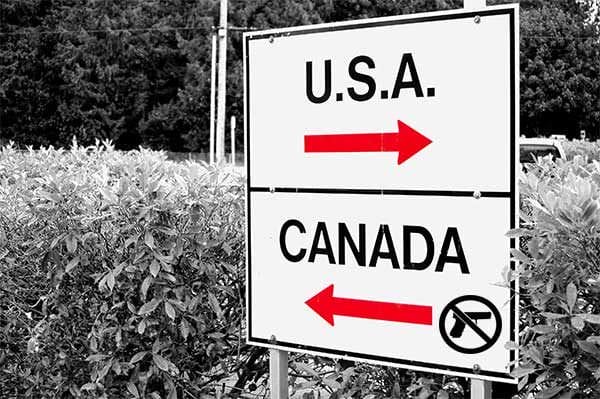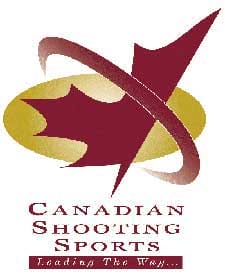

They open with this inflammatory voiceover from one of the conservation officers:
“Definitely a safety risk to have that many gravel pits and people shooting.”
They offer no evidence to back up the claim. They just leave it hanging as if it were Gospel. If it were that dangerous, surely our hospitals would be overrun with patients suffering from gunshot wounds. They are not.
At its 30-second mark, the CBC video features the graphic stating:
“One in five Canadians own at least one firearm.”
That statement is bracketed with handgun silhouettes on both sides, implying all those Canadians own handguns.
While we appreciate the support of the CBC in ramping up the number of gun owners in Canada, they fail to tell the truth. Based on Canada’s current population of 35,530,532, the CBC’s claim that one in five Canadians owns at least one gun means 7,306,101 Canadians are licensed to own firearms.
If that were true Canadian gun owners would control every single federal election. The reality is far different than the CBC portrayal, of course. According to the latest RCMP statistics in the 2015 Commissioner of Firearms report, there are only 2,026,011 licensed firearm owners in Canada.
The video features two British Columbia conservation officers visiting people shooting at gravel pits near Slave Lake, or as the CBC characterizes it, “the notorious sport shooting hotspot of Slave Lake, BC.” The conservation officers are there to check on licenses:
“We’re just going to take a look at the guns, so we’re just going to be inspecting to make sure that the guns are legal, right, there’s serial numbers, there’s PALs, all that sort of stuff. So it’s just to make sure everybody’s following the rules.”
It would be helpful if the conservation officers knew the law. Unfortunately, they do not.
At the 1-minute mark, one conservation officer, Sgt. Todd Hunter, holds up a banana magazine and explains what would make it legal or illegal:
“What would make it a restricted device here, a magazine, it would be unpinned and it would be able to hold more than five rounds.”
A magazine capable of holding more than five rounds in a semi-automatic rifle is a prohibited device, not restricted as Sgt. Hunter states.
The video cuts to a shotgun magazine laying on the bed of a truck with shotgun shells placed on top of it. Officer Clayton DaBruin counts the number of shotgun shells and makes this pronouncement:
“This banana clip or magazine appears to take more than ten shotgun shells so, sometimes people will order things internationally from the U.S. where the laws might allow these type of modifications and devices but in Canada we’ve got some restrictions that prohibit it, prohibit the amount of casings and shells you can fit into a magazine.”
The video cuts to a shot of the conservation officer’s truck with the following voiceover:
“It is illegal to possess that magazine so I’m going to be seizing it from you.”
What the video never shows is the shotgun that magazine is designed to fit. If the firearm in question is a pump action shotgun, then the magazine is legal and should not be seized. Only if the magazine is designed for a semi-automatic shotgun would it be a prohibited device and therefore illegal to possess.
Near the end of his discussion of what makes a firearm fully automatic, Sgt. Todd Hunter places his left hand over the barrel and uses his hand to push the firearm into the bed of the truck.
The CBC video then shows a graphic stating:
“Replica firearms present a special challenge for conservation officers.”
That statement is followed by another graphic stating:
“It’s not always easy to tell if they are compliant with Canada’s gun regulations.”
Officer Clayton DaBruin then talks about a rifle as he examines it:
“A lot of these new sporting rifles, most of them are in the non-restricted class, but there are a select few which mimic an army rifle. If they can be shortened, if they can be concealed easier, and so we have to confirm by use of the manufacturer and model number and the serial number that it is in fact a replica and is allowed to be out here on the forest service roads.”
Clearly neither the CBC nor Officer Clayton DaBruin knows what they are talking about. The CBC took Officer DaBruin at his word, not realizing the officer did not understand the difference between replica firearms, restricted firearms and prohibited devices.
The RCMP fact sheet for replica firearms states:
“A replica firearm is a device that is not a real firearm, but that was designed to look exactly or almost exactly like a real firearm. Replica firearms are prohibited devices in Canada.”
Officer DaBruin then explains to the young man that he is pleased to see a trigger lock on his non-restricted firearm.
“I checked your mags, that’s five rounds. That’s what I like to see even though it looks like a ten to fifteen round mag. I appreciate the trigger lock. Here’s your PAL and your driver’s license and you’re free to go.”
While Officer DaBruin is pleased to see a trigger lock on a non-restricted firearm, the fact is trigger locks are not required to transport non-restricted firearms.
The RCMP’s Storing, Transporting and Displaying Firearms information page states:
“Non-restricted firearms must be unloaded during transportation.”
The next time the CBC wants to shoot a segment to educate people about firearms and firearm law, we strongly suggest the CBC consult with someone knowledgeable about firearms and firearm law. It stops them from looking stupid and presenting misinformation to the public.
All the CBC proved with their segment “Guns in Canada 101,” is neither they nor the people empowered to enforce Canada’s firearm laws know what they are talking about.
References:
- CBC Keeping Canada Safe: Guns in Canada 101: https://www.cbc.ca/keepingcanadasafe/features/guns-canada-101
- Canada’s current population: https://www.worldometers.info/world-population/canada-population/
- 2015 Commissioner of Firearms Report: https://www.rcmp-grc.gc.ca/en/2015-commissioner-firearms-report
- Replica firearms are prohibited devices in Canada: https://www.rcmp-grc.gc.ca/cfp-pcaf/fs-fd/replica-replique-eng.htm
- RCMP Storing, Transporting and Displaying Firearms information page: https://www.rcmp-grc.gc.ca/cfp-pcaf/fs-fd/storage-entreposage-eng.htm
About CSSA:
The CSSA is the voice of the sport shooter and firearms enthusiast in Canada. Our national membership supports and promotes Canada’s firearms heritage, traditional target shooting competition, modern action shooting sports, hunting, and archery. We support and sponsor competitions and youth programs that promote these Canadian heritage activities.
For more information, visit the website at www.cdnshootingsports.org.

So has the CBC been advised of the inaccuracy of their report ?
Dudley Do Wright could do a better job
Than these misguided excuses for RMCP
The RCMP interpreting laws they haven’t even read…Again !!!
Sounds a little like commifornia!!!
The media n Canada is antigun, always have been, will will continue, they never tell us how many dies from suicides, drug overdose, death by Doctor errors, highwy accidents , etc. Unfortunately they play the gun card, must sell papers and increase their viewership, sad but true,
Inky Mark, former MP
What a bunch of convoluted garbage they have up there. I feel bad for anyone that has to tolerate just illogical nonsense.